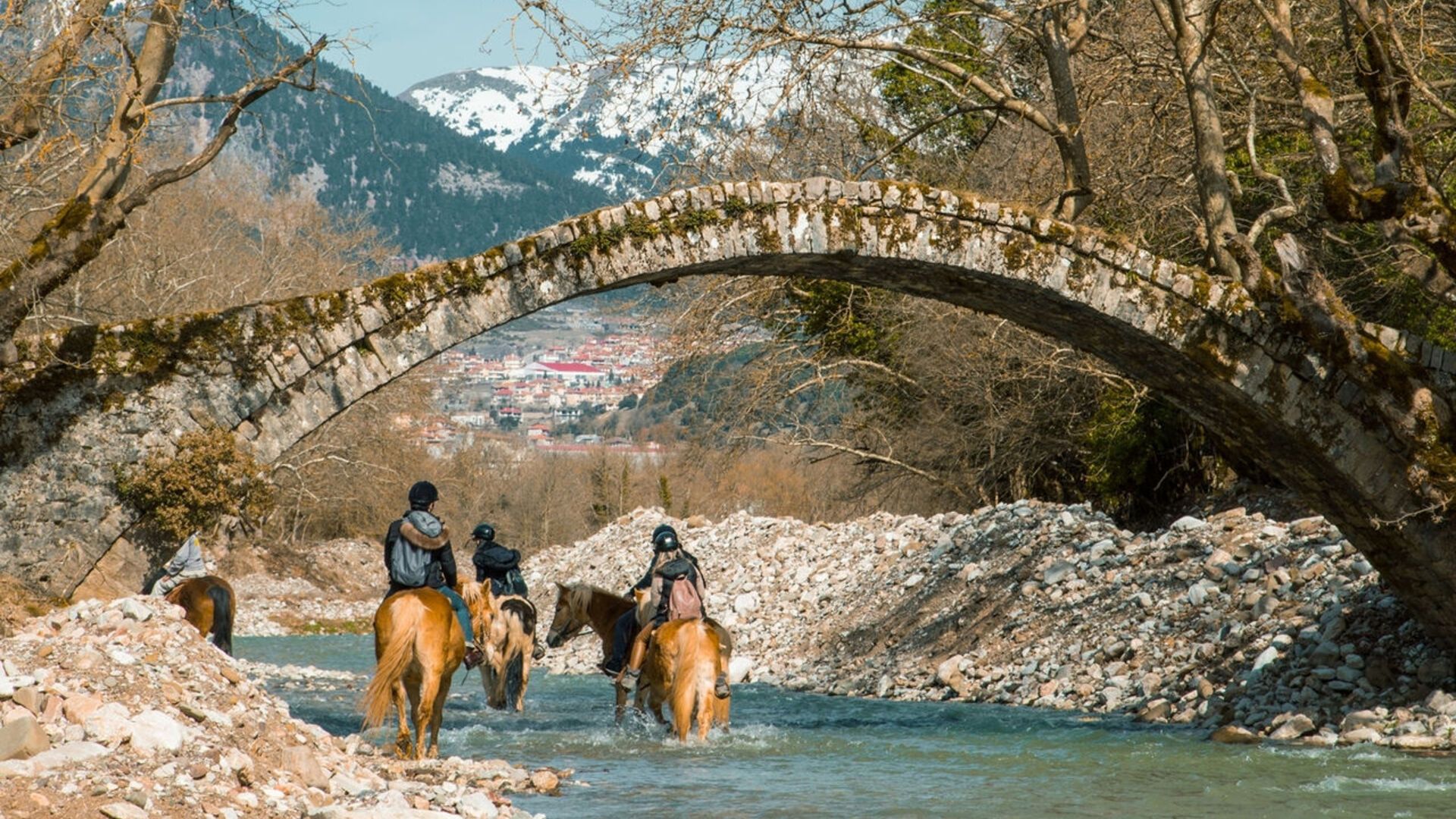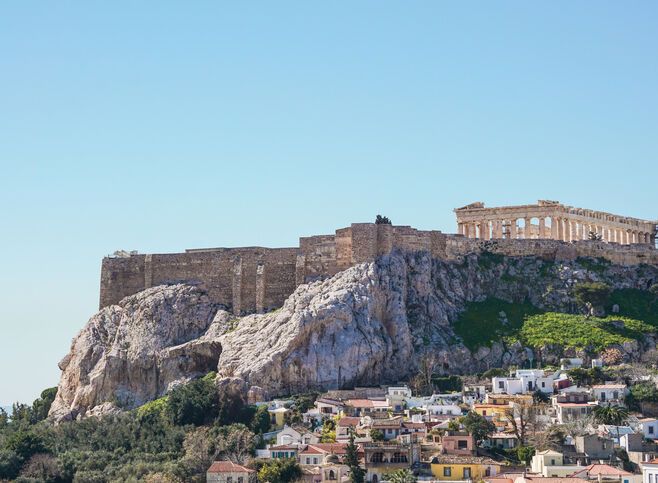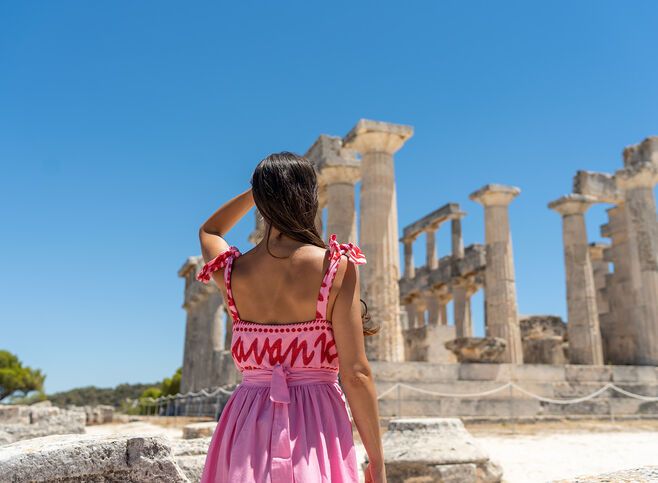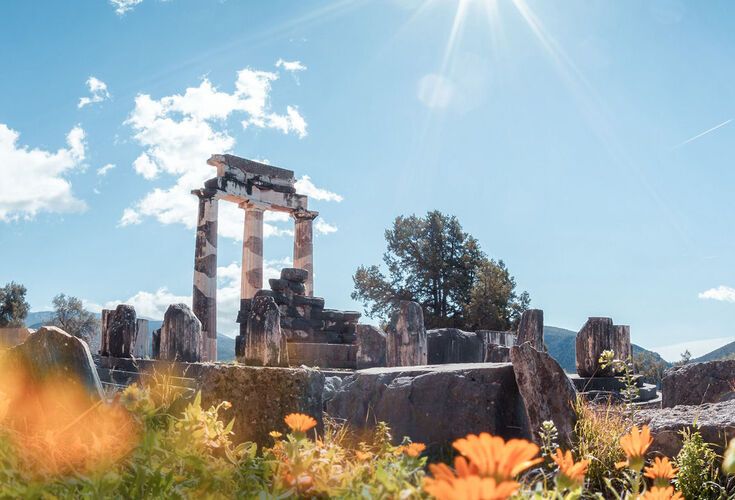Located above the temple of Apollo, the ancient theatre looks over the entire sanctuary and a valley of olive trees
+6
The harmony that bound men and their gods is still apparent in Ancient Delphi. Photographs cannot do justice to the grandeur and serenity of the setting. Nor can words express the emotions that this holy place provoke. The eagles, dispatched by Zeus to find the centre of the earth, met here. And it is where the god Apollo founded his sanctuary when he killed the dragon Python.
The Delphic landscape of Central Greece and the archaeological site (easily amongst the most important archaeological sites in Greece and a UNESCO World Heritage Monument since 1972) are a gift to humanity. In Delphi, you will bow to what men and nature made together, a creation beyond place and time. And you’ll discover your deeper self as the power of human potential and divine energy resonate within you.
Feel the aura of the archaeological site of Ancient Delphi
Layers of myth and history enhance the natural magnificence of Delphi in Greece. It is said that Zeus sent two eagles in opposite directions to determine the fulcrum of all existence. When they met there, he proclaimed it the “navel of the world”. Tradition also relates that a sanctuary existed at ancient Delphi, dedicated to Mother Earth and guarded by the dragon Python. Apollo, disguised as a dolphin, arrived at Kirra, Delphi’s port, slew the dragon and founded his own sanctuary in its place, the Temple of Apollo.
The Delphic oracle was an important spiritual and religious centre from the 6th century BC to the 4th century AD and rewarded the god-fearing with credible, if ambiguous, prophecies. Ancient pilgrims expressed their gratitude in the form of dozens of magnificent offerings that came to light during excavations.
You can still feel the divine presence in every atom of this spell-binding location. Two giant cliffs at the foot of Mt Parnassos – the Phaidriades (Shining Rocks) – overlook the oracle and the sanctuary. The surrounding area from Arahova to Kirra is a vast silver-green olive grove. Together, they form the famous Delphic landscape. Soothing yet wild, dramatic yet welcoming, it seems to sway to an inaudible score that floods the soul with the music of the gods.
Like a worshipper in ancient times, you’ll walk up the Sacred Way to the majestic Temple of Apollo, which was decorated by Athenian sculptors. Pythia issued her prophecies from its inner sanctum. The temple is surrounded by monuments dedicated to the ancient Greek city-states, leaders and ordinary people and the whole place still exudes a unique energy.
Stand before it and look carefully at the ruins. They date from a temple built in 330 BC on the foundations of an earlier Doric temple erected in 505 BC. North of the sanctuary, you’ll find the theatre, where music and drama contests were held. Walk even higher and you’ll come to the Stadium, where the Pythian Games took place.
In a landscape of surreal, mystical beauty, the spring gushes from the base of Phlemboukos rock in the crevice formed by the twin cliffs. It was here that Pythia and her priests washed and purified themselves, as did every ordinary mortal before they approached the Oracle. The history of the oldest fountain dates from the 6th century BC. In the 1st century, the Kastalia of the Rock was created closer to the spring. Niches cut into its sides held offerings left to the nymph Kastalia. You are now at the very source of the myth.
Remains of its past glory fill the site of Delphi. Among them are the Tholos shrine of Athena Pronaia, the unusual circular structure whose function remains unknown; the Gymnasium, where athletes trained and worked out; the Palaistra or wrestling arena; and the Baths from the Classical period near those from the Roman era.
Ancient Delphi’s museum is one of the most important in Greece. It was built in 1903 to house finds from the first great excavations that began in 1892. In 2004, the space was renovated and expanded and the exhibits enlarged and rearranged according to modern standards. The result is fascinating. Don’t miss the marvellous Charioteer, the focal point for many of the thousands of visitors who yearly pass through its 14 rooms.
A contemporary cultural centre in Delphi, it hosts performances, conferences, international symposia on ancient theatre and exhibitions of Greek and foreign artists. It was founded on the initiative of former Prime Minister Constantine Karamanlis to create a pan-European and global centre for intellectual pursuits near the town. The conference complex, a representative example of the Modern Movement in architecture, was built in the 1960s. An interesting sculpture park surrounds it.
Early in the 20th century, the major Greek poet Angelos Sikelianos and his American wife, Eva Palmer, sought to revive Delphi as a world centre. In the first Delphic Festival in 1927, ancient prestige shone once more with a performance of Aeschylus’ Prometheus Bound in the ancient theatre and, again, in 1930 with another of his plays, The Suppliants.
Today, in Sikelianos’s house-museum, one of the many attractions you’ll encounter near the modern town, you will see manuscripts and correspondence concerning the festivals, photographs, by the celebrated Greek photographer, Nelly, and costumes designed by Eva, based on vase paintings and woven on her own loom.
Here you’ll find excellent hotels, restaurants, cafe/bars, shops selling folk art and replicas of finds from the archaeological site. And that same extraordinary view of the dramatic mountain above a sea of olive trees.
From a large triangular opening, you’ll enter a cave whose subtle lighting enhances the amazing stalactites and stalagmites. The Corycian Cave, the grandest on Parnassos, was also a treasure chest of very old finds dating to the Neolithic era (4000 BC). In the 5th century BC, Pan and the Nymphs were worshipped here. It still emits an aura of mysticism.
Follow one of the best-known hiking paths in the area. A large stretch of it was actually the ancient path described by Pausanias, the 2nd century AD traveller and in many respects the originator of the modern concept of the ‘guidebook’. Now a section of the international E4 route, it leads from Ancient Delphi up to a place called Kroki.
You’ll enjoy this gentle downhill path that traces the ancient road that linked the port of Kirra with Delphi. Follow the footsteps of the pilgrims, reach an altitude of 550 meters, and enjoy a scenic walk through olive forests and rivers.
In Ancient Greece, Delphi was the most important oracle where people would travel and consult the high priestess Pythia. Today, it is a major archaeological site featuring a temple, theatre and stadium.
The word Delphi comes from the ancient Greek word “Delphus”, meaning womb, because Mother Earth worshipped there during the Mycenean era. Additionally, Delphos, the son of Apollo or Poseidon, conceived the art of fortune-telling.
Ancient Delphi was believed to be the centre, or “the navel”, of the earth because there is the same distance (exactly 121 km) between Delphi and the most important religious sites of ancient Greece, namely the Acropolis in Athens and the Temple of Aphaia on the island of Aigina.




















